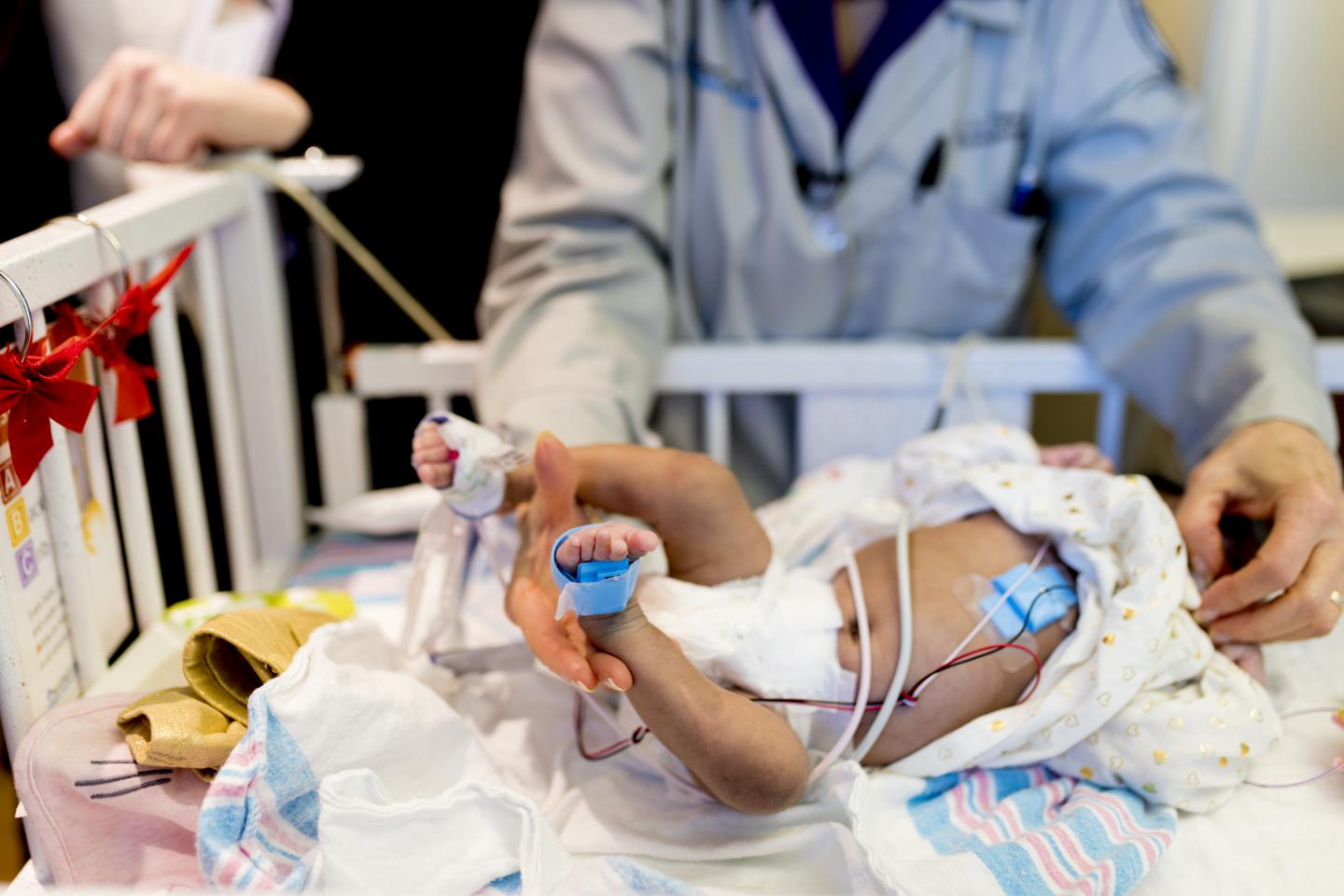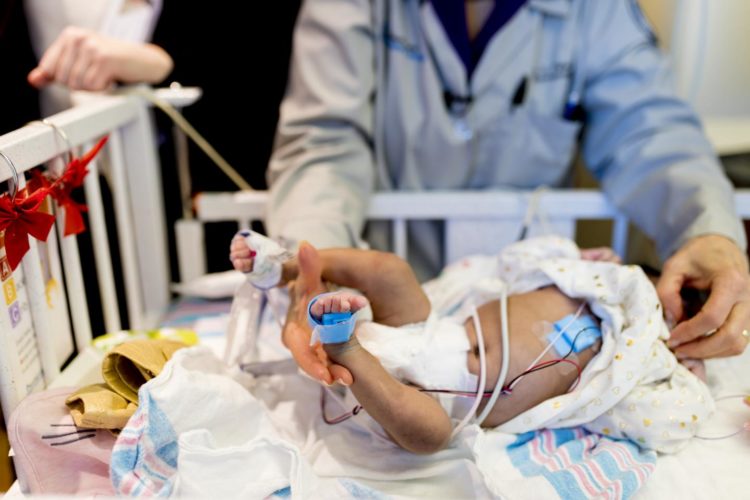Soft, flexible devices are being tested, evaluated in Ghana, India, Kenya and Zambia

Credit: Northwestern University
EVANSTON, Ill. — Every year, 15 million babies are born too early, with 1 million never making it to their next birthday. And in low-resource settings, the outlook is even more dire. Half of babies born at 32 weeks or earlier will die; whereas in high-resource settings, almost all of these babies survive.
To help bridge this gap, an interdisciplinary team of Northwestern University researchers has developed a new wireless, battery-charged, affordable monitoring system for newborn babies that can easily be implemented to provide clinical-grade care in nearly any setting.
The new devices also exceed the capabilities of existing, wired monitoring technologies to provide information beyond traditional vital signs, including crying, movement, body orientation and heart sounds. These soft, flexible sensors also are far gentler on newborns’ fragile skin, and their wireless capabilities allow for more skin-to-skin contact with parents.
Not only can this technology lower risks by monitoring premature babies, it can also is monitor pregnant women during labor to ensure a healthy and safe delivery and reduce risks of maternal mortality. By closely monitoring the most vulnerable patients, physicians can be alerted to intervene before the infant or mother become seriously ill.
Details about the technology will be published March 11 in the journal Nature Medicine, with extensive tests on newborns at Ann & Robert H. Lurie Children’s Hospital of Chicago and Prentice Women’s Hospital in Chicago. The sensors described in the paper also are now being tested on newborns at Aga Khan University Hospital Nairobi, Kenya and on pregnant mothers in the University Teaching Hospital in Lusaka, Zambia.
‘From the hospital to the home to the field’
Led by Northwestern’s John A. Rogers, a pioneer in the emerging field of bio-integrated electronics, the research team developed the sensors last year and tested them on babies in the United States. Now, with support from the Bill & Melinda Gates Foundation and Save the Children, his team is deploying the devices internationally, starting with hospitals in Ghana, India, Kenya and Zambia.
“We designed our technology to offer affordable, clinical-grade monitoring capabilities for use anywhere in the world — from the hospital to the home to the field,” Rogers said. “Using advanced concepts in soft electronics, we achieved devices that are safe, easy to use and patient-centric. We included in our research a focus on features to allow application in low-resource settings in the developing world, where this type of technology has the greatest potential to improve and possibly save lives.”
“The new technology represents a monumental advance in neonatal and pediatric care,” said Dr. Debra Weese-Mayer, a pediatrician in autonomic medicine at Northwestern University Feinberg School of Medicine, who co-led the study with Rogers. “This is not strictly about making critical care systems ‘wireless’, this is about thinking expansively about what non-traditional variables we need to incorporate to more fully study health and ensure stability.”
Rogers is the Louis Simpson and Kimberley Querrey Professor of Materials Science and Engineering and Biomedical Engineering in Northwestern’s McCormick School of Engineering and professor of neurological surgery in Feinberg. He also is executive director of the Querrey Simpson Institute for Bio-electronics at Northwestern. Weese-Mayer is the Beatrice Cummings Mayer Professor of Pediatric Autonomic Medicine at Feinberg and chief of pediatric autonomic medicine at Lurie Children’s Hospital.
Reliable in areas without stable power
The new study builds on previous research conducted in the Rogers lab. Last February, Rogers and his collaborators published results from a study conducted at Lurie Children’s Hospital and Prentice Women’s Hospital in Chicago. Here, researchers tested a pair of wireless, battery-free, flexible sensors on premature babies. The sensors proved to be as precise and accurate as traditional wire-based monitoring devices that interfere with parent-baby cuddling and physical bonding.
To move these platforms from Chicago into the developing world, Rogers’ team added a small, thin, rechargeable battery to give the device stable, reliable power for operation in rural settings and to improve the wireless operating range. The team also added extra sensing capabilities to monitor crying, movement and heart sounds.
“We couldn’t just drop our existing technology into other countries and different settings without taking their specific needs into account,” Rogers said. “We wanted to understand the broader landscape and to develop a technology that is easy-to-use, helpful and practical. We knew that we needed to build the foundations for highly robust, reusable devices, applicable in regions with limited facilities and resources.”
“Some areas experience rolling blackouts every day and uneven internet coverage,” said Dr. Shuai (Steve) Xu, a Northwestern Medicine dermatologist and co-first author of the study who leads deployment of the system on the ground. “People in these areas need a practical device that works and is cheaper to manufacture.”
Sensors send data to mobile devices
The sensors use radio frequencies to wirelessly transmit data from the baby to nurses’ station displays. They also can send data directly to a smartphone or tablet.
“The beauty of the technology is that it can operate with a wide range of mobile devices without sacrificing accuracy, relative to the most sophisticated systems used in hospitals today,” Xu said. “You don’t need expensive equipment that requires a specialized bioengineer and I.T. department to install. You pull out your mobile device, connect to our sensors, and you’re taking care of patients.”
Implementing technology abroad
Xu, the medical director of the Querrey Simpson Institute for Bio-electronics, assistant professor of dermatology and pediatrics at Feinberg and assistant professor of biomedical engineering at McCormick, has spent the past six months leading a team of engineers in setting up the technology in hospitals in Kenya and Zambia, working with nurses and physicians. The program will involve testing the sensors on 15,000 pregnant women and 500 newborn babies by mid-2021.
“This is a collaborative team effort,” Xu said. “We’ve spent a lot of time working with and listening to physicians, nurses and health care workers in each location. We want to make sure that our technology is useful and helps solve problems they face every day. It’s been incredibly motivating.”
So far, 42 babies in Kenya have worn the wireless sensors alongside gold-standard, traditional monitoring systems so researchers could do a side-by-side, quantitative comparison. After validating the device at Aga Khan University Hospital, the team plans to move the technology to low-resource hospitals in rural Africa, where the need is greatest.
“The urgency of need in Nairobi is significant, but nothing compared to that in the rural areas,” Rogers said. “There’s room for improvement everywhere, but the added value of making affordable health care monitoring systems is so much higher in these settings.”
Collaborating with nurses abroad
Rogers and Xu said the early feedback from hospital nurses has been invaluable. The sensors work in pairs — one on the chest and one wrapped around a foot. In an earlier version of the technology, nurses worried that the chest sensor might be too large for small, fragile newborns. Rogers and his team immediately responded to this feedback to make a smaller, thinner chest device.
“The nurses have been enthusiastic about the new iteration,” Rogers said. “These latest platforms also are giving us great data. When we put the sensor on the baby, it starts working immediately, in nearly any setting or location.”
Nurses also have struggled with perfecting the foot sensor’s alignment. If the sensor is not correctly wrapped around the foot, then the data are not as accurate.
“It takes some practice to quickly align the foot sensor,” Rogers said. “So we designed a system that lights up as red, yellow or green — incorrect, close or in the right place — depending on the accuracy of the alignment, to provide feedback to the caregiver.”
‘Mothers love our sensors’
The team also has received encouraging feedback from parents, who benefit from more physical bonding or “kangaroo care.” Dennis Ryu, a Ph.D. student in the Rogers lab, spent six weeks on the ground at Aga Khan University Hospital in Nairobi, Kenya and University Teaching Hospital in Lusaka, Zambia with plans to return this spring.
“Mothers love our sensors because they can have more skin-to-skin contact with their babies,” Ryu said. “Kangaroo care has profound benefits for the mother and baby, including bonding, better sleep and less stress.”
“Suggestions come directly from speaking to people on the ground and directly observing how our sensors are used,” Xu added. “It really is a bi-directional information flow.”
What’s next?
With an exclusive license to the technology from Northwestern, Rogers and Xu launched Sibel Health to scale the technology and to earn FDA approval later this year, with a focus on maternal, fetal, neonatal and pediatric health. More recently, Sibel announced a strategic partnership with Dräger, a leading international safety and medical technology company that focuses on products that protect, support and save lives.
Next, Rogers and Xu plan to incorporate artificial intelligence into the sensors to extract insights from the data and provide health care professionals with recommendations for care.
“These systems are generating half a gigabyte of data for one patient a day. That’s a lot of physiological information,” Xu said. “We’d like to use clinically validated algorithms that could, for example, tell us if a baby is likely to develop sepsis within the next 24 hours based on their vital signals. Then we could have ventilators and antibiotics ready to escalate care almost proactively. For pregnant women, we’re working with Dr. Jeffrey Stringer — the director of the division of Global Women’s Health at University of North Carolina at Chapel Hill — with funding from the Bill & Melinda Gates Foundation to more quickly identify danger signals in low-resource settings.”
Rogers estimates these new wireless sensors could appear in U.S. hospitals within the next year. His team also expects to send sensors to more hospitals in countries around the world as part of an ongoing international effort to improve affordable health care monitoring.
“We believe that our technology could significantly enhance the quality of neonatal care around the world,” Rogers said. “We think in terms of a ‘NICU of the future,’ available anywhere.”
“The vision is bold,” Xu said. “We want to see these sensors in every country, monitoring the first heartbeat to the last in our most vulnerable patients.”
###
The paper’s first authors, who are all from Northwestern, are Ha Uk Chung, Alina Rwei, Aurélie Hourlier-Fargette and Dr. Xu.
The study, “Skin-interfaced biosensors and pilot studies for advanced wireless physiological monitoring in neonatal and pediatric intensive care units,” was supported by the Bill & Melinda Gates Foundation (award numbers OPP1182909, OPP1193311 and INV-000787), the Gerber Foundation, Save the Children (award number 999002170), National Institutes of Health (grant number TL1TR001423) and the National Science Foundation (grant numbers 1400159, 1534120 and 1635443).
Editor’s note: Rogers and Xu have financial interests in and affiliations with Sibel Health. Northwestern University has financial interests (equities, royalties) in Sibel Health.
Media Contact
Amanda Morris
[email protected]
847-467-6790
Related Journal Article
http://dx.





